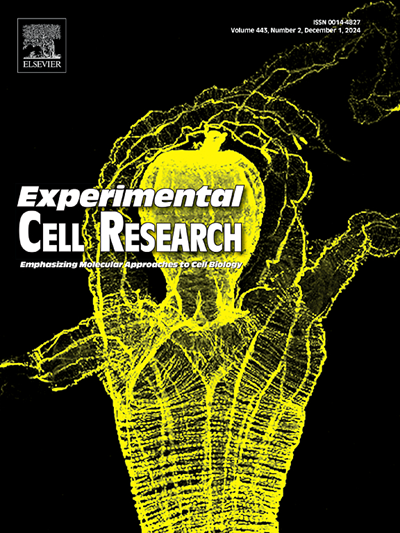SIRT3 mitigates high glucose-induced damage in retinal microvascular endothelial cells via OPA1-mediated mitochondrial dynamics
IF 3.3
3区 生物学
Q3 CELL BIOLOGY
引用次数: 0
Abstract
Oxidative stress in endothelial cells is pivotal in diabetic retinopathy (DR), with mitochondrial homeostasis being crucial to mitigate this stress. This study explored the roles of mitochondrial sirtuins (SIRTs) in high glucose (HG)-induced oxidative stress, related endothelial impairment, and mitochondrial homeostasis damage in rat retinal microvascular endothelial cells (RMECs). RMECs were cultured under HG or equivalent osmotic conditions. Cell viability was assessed using the Cell Counting Kit-8 assay, whereas cell death and survival were determined via calcein-AM/propidium iodide double staining. Reactive oxygen species (ROS) levels were measured using 2′,7′-dichlorofluorescein fluorescence. Expression of mitochondrial SIRTs3-5 and key mitochondrial homeostasis molecules was quantified by the quantitative real-time polymerase chain reaction and confirmed by western blotting. Mitochondrial morphology was evaluated using electron microscopy and the MitoTracker fluorescent probe. A SIRT3-overexpressing RMEC line was constructed to assess the role of SIRT3 in oxidative stress and mitochondrial dynamics. After 48 h of HG exposure, cell viability was significantly reduced, with a concomitant increase in cell death and ROS levels, alongside a marked decrease in SIRT3 expression and molecules associated with mitochondrial dynamics. SIRT3 overexpression reversed these effects, particularly increasing the mitochondrial fusion-related molecule, optic atrophy 1 (OPA1). However, the OPA1 inhibitor, MYLS22, blocked the protective effect of SIRT3, leading to more dead cells, a higher ROS level, and intensified mitochondrial fragmentation. These results suggest that SIRT3 is involved in HG-induced imbalanced mitochondrial dynamics of endothelial cells in DR, potentially through the OPA1 pathway.
SIRT3 通过 OPA1 介导的线粒体动力学减轻高血糖诱导的视网膜微血管内皮细胞损伤。
内皮细胞的氧化应激在糖尿病视网膜病变(DR)中起着关键作用,而线粒体的平衡对缓解这种应激至关重要。本研究探讨了线粒体sirtuins(SIRTs)在高糖(HG)诱导的氧化应激、相关内皮损伤和大鼠视网膜微血管内皮细胞(RMECs)线粒体稳态损伤中的作用。在 HG 或同等渗透条件下培养 RMECs。使用细胞计数试剂盒-8 评估细胞活力,而细胞死亡和存活则通过钙黄绿素-AM/碘化丙啶双重染色来确定。活性氧(ROS)水平用 2',7'-二氯荧光素荧光测定。线粒体 SIRTs3-5 和关键线粒体稳态分子的表达通过定量实时聚合酶链反应进行量化,并通过 Western 印迹法进行确认。使用电子显微镜和 MitoTracker 荧光探针对线粒体形态进行了评估。为了评估 SIRT3 在氧化应激和线粒体动力学中的作用,构建了一个 SIRT3 表达过高的 RMEC 株系。暴露于 HG 48 小时后,细胞活力明显降低,同时细胞死亡和 ROS 水平增加,SIRT3 表达和线粒体动力学相关分子明显减少。SIRT3 的过量表达可逆转这些影响,尤其是线粒体融合相关分子视神经萎缩 1(OPA1)的增加。然而,OPA1 抑制剂 MYLS22 阻断了 SIRT3 的保护作用,导致更多的死亡细胞、更高的 ROS 水平和线粒体破碎加剧。这些结果表明,SIRT3 可能通过 OPA1 途径参与了 HG 诱导的 DR 内皮细胞线粒体动力学失衡。
本文章由计算机程序翻译,如有差异,请以英文原文为准。
求助全文
约1分钟内获得全文
求助全文
来源期刊

Experimental cell research
医学-细胞生物学
CiteScore
7.20
自引率
0.00%
发文量
295
审稿时长
30 days
期刊介绍:
Our scope includes but is not limited to areas such as: Chromosome biology; Chromatin and epigenetics; DNA repair; Gene regulation; Nuclear import-export; RNA processing; Non-coding RNAs; Organelle biology; The cytoskeleton; Intracellular trafficking; Cell-cell and cell-matrix interactions; Cell motility and migration; Cell proliferation; Cellular differentiation; Signal transduction; Programmed cell death.
 求助内容:
求助内容: 应助结果提醒方式:
应助结果提醒方式:


